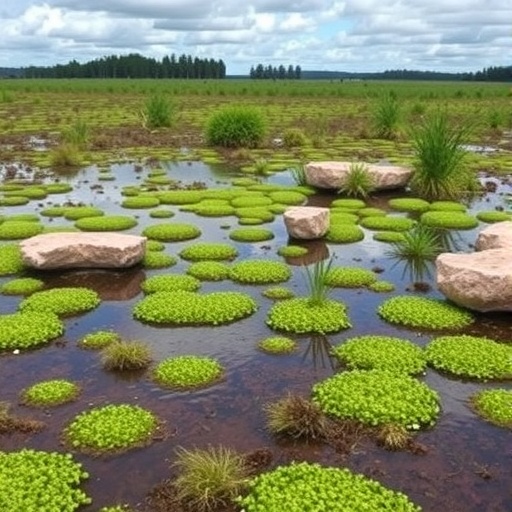In recent research published in the esteemed journal Science, scientists have raised critical concerns regarding the impact of extreme drought on peatlands, which play a pivotal role in carbon storage and the regulation of global climate. These wetlands, comprising only 3% of the Earth’s surface, astonishingly hold more than 30% of the world’s soil carbon, making them a natural treasure for climate mitigation. However, the new findings illustrate that under severe drought conditions, particularly in a warming climate, the carbon that these ecosystems sequester could be severely jeopardized, with potential losses threatening to erase centuries’ worth of carbon stores in mere months.
The study, dated October 23, illuminates the extent to which extreme drought events can amplify carbon release from peatlands. Conducted under scenarios that simulate future climate conditions—characterized by increased temperatures and higher carbon dioxide levels—the research indicates that extreme drought can increase carbon output from these ecosystems by nearly threefold. This alarming discovery suggests that as droughts become more frequent and intense due to climate change, the risks associated with peatland carbon loss are escalating significantly.
Yiqi Luo, the lead researcher and a notable figure in the realm of ecosystem science, emphasizes the gravity of these findings. He articulates how rising temperatures are likely to lead to more frequent and severe droughts, which subsequently heighten the vulnerability of peatlands. The losses associated with these ecosystems are not negligible; the research indicates that extreme drought could eliminate between 90 and 250 years of carbon sequestration in just a few months. Luo’s assertion stresses the urgent need to address the implications of global warming on peatlands, given their disproportionate contribution to carbon mitigation efforts when compared to their small geographical footprint.
Previously established research has already indicated that drought conditions hinder ecosystem productivity and contribute to heightened carbon release from peatlands. However, this recent study is groundbreaking in that it meticulously examines the interplay between climate change factors and their cumulative effects on carbon loss in these vital ecosystems. With the Intergovernmental Panel on Climate Change projecting that extreme drought could become 1.7 to 7.2 times more likely in the near future, Luo affirms the necessity for scientists and policymakers to consider the precarious state of peatlands as integral to our climate change mitigation strategies.
The researchers harnessed data from the Spruce and Peatland Responses Under Climatic and Environmental Change (SPRUCE) project, an ongoing field experiment situated within a natural boreal spruce bog in Minnesota. At this site, scientists have developed specialized chambers that simulate various climate conditions, allowing for precise monitoring and analysis. The study particularly focused on carbon dynamics during a significant drought period in summer 2021, revealing that water tables take considerably longer to recover under elevated temperatures and carbon dioxide levels, resulting in increased carbon emissions.
Expectations among researchers that warmer climates would correlate with heightened carbon loss during droughts were validated. Still, the findings regarding elevated carbon dioxide levels exacerbating carbon release were surprising. While previous studies have often pointed out that higher carbon dioxide could mitigate the impacts of extreme conditions in some ecosystems, the current research showcases a starkly different reality for peatlands. The combination of increased temperature and elevated carbon dioxide, yielding a 9-degree Celsius rise, led to dramatic spikes in carbon emissions during the observed drought event in 2021.
Further analysis conducted by Quan Quan, a postdoctoral researcher and first author of the paper, indicated that higher carbon dioxide levels corresponded with an increase in both substrate and dissolved carbon within the peat bog. This combination is critical since, during drought conditions, the exposure of dissolved carbon to oxygen promotes enhanced carbon dioxide release into the atmosphere, further exacerbating climate change.
This study serves as a clarion call for heightened awareness and proactive measures regarding the management and conservation of peatlands. The research team, part of the Oak Ridge National Laboratory consortium, comprises over 250 scientists dedicated to understanding the implications of environmental changes on peatland ecosystems. They strive to integrate data collection and modeling approaches to elucidate how peatlands will respond to ongoing climate pressures.
Local and national funding bodies, including the U.S. Department of Energy and the National Science Foundation, facilitated this significant research, underscoring the multidimensional support for climate-related studies. With collaborative efforts involving prestigious institutions across the globe, the work exemplifies the interdisciplinary approaches necessary to tackle the complexities of climate change.
In conclusion, the implications of this study are profound, suggesting that immediate actions are required to mitigate the adverse effects of climate change on peatlands. It is imperative for scientists, policymakers, and the public to understand the critical role these ecosystems play in stabilizing our climate and to actively seek solutions that preserve their integrity in the face of daunting climate challenges. The stakes associated with this fragile environment are high, and the outcomes of failing to address these threats could reshape our climate for generations to come.
Subject of Research: Peatland carbon loss due to extreme drought in a warming climate.
Article Title: Extreme Drought Could Unleash Carbon from Peatlands, Threatening Climate Stability
News Publication Date: October 23, 2023
Web References: N/A
References: N/A
Image Credits: N/A




